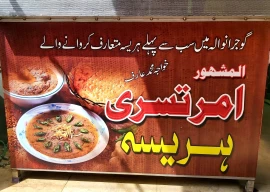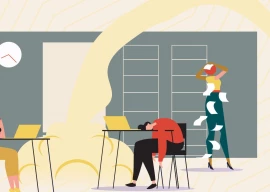
The show fuses Pakistani with Indian, Islam with Hinduism and North American with South Asian, without highlighting the major chasms separating these dichotomies in the Eastern world. The subtext of the works largely communicate with Suri’s music: both are compendiums of deep knowledge of pop culture and both American and South Asian.

An antique Indian tin and mixed media, by Himanshu Suri and Chirag Bhakta. PHOTO CREDITS: RYAN MUNIR
Collage and street art seem to be the common threads tying the works together. In a work by Suri and the artist known as Pardon My Hindi, household objects, including an asthma inhaler and a prescription bottle, are juxtaposed with imagery from an airplane’s safety guide, in reference to assemblage curiousity cabinets by the venerated 20th century American artist Joseph Cornell. Other works, such as the optical illusion of a black-and-white 3-D sculpture of a stack of 1-D boxes which spirals upwards and into the distance, directly refer to top pop art artists like Andy Warhol and Patrick Caulfield. South Asian culture is also under scrutiny with works such as the brightly-coloured relief of a caricaturised Hindu god.
Much like Suri’s album Eat Pray Thug, the exhibition draws upon personal, lived experiences, while casting a critical eye at western commercialism. The media and day-to-day life are the targets in this eclectic exhibition. In line with mid-20th century pop artists who fed contemporary culture to high-end audiences via advertisements and television serials, the exhibit includes the work of artist Roohi Ahmed from Karachi who entered a visceral video of herself sewing red thread through her hands. But the artist who most caught my eye was another Karachi-based practitioner, Adeela Suleman, whose comedic work captures the dark Pakistani sense of humour, often taking current events into critical consideration.
‘Eat Pray Thug’ is a nod to the hugely popular travel memoir Eat, Pray, Love: One Woman’s Search for Everything across Italy, India and Indonesia by American author Elizabeth Gilbert. With this reference, the exhibit points towards two cultural tenets integral to both Pakistanis and Indians alike: food and prayer. Suri’s cheeky inclusion of ‘Thug’ in lieu of ‘Love’ is a reminder of the prevalent negative stereotypes attached to being a minority in the United States. For Suri, it may be referencing his skin color and Indian heritage; yet, it resonates equally with how born-in-Pakistan Muslims are categorised in the international media as well.

Upright, 2012, by Aakash Nihalani. PHOTO CREDITS: RYAN MUNIR
Overall, the show brings forward a strain of South Asian voices represented but not fully recognised. It appears local yet foreign which manages to appeal to younger audiences as well as the more seasoned gallery visitors.
Carol Khan is a subeditor and coordinator of The Express Tribune in Peshawar. She tweets @carolkhan_
Published in The Express Tribune, Sunday Magazine, March 15th, 2015.

















COMMENTS
Comments are moderated and generally will be posted if they are on-topic and not abusive.
For more information, please see our Comments FAQ